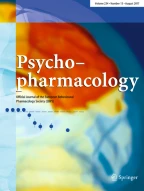Abstract
A possible involvement of glucocorticoids in the aetiology of depression is suggested by commonly reported hypothalamo-pituitary-adrenocortical (HPA) axis abnormalities in depressed patients, the modulation of the HPA axis by antidepressant drugs and clinical reports of antidepressant efficacy with antiglucocorticoid agents. The effects of treatment with metyrapone, a glucocorticoid synthesis inhibitor, and the tricyclic antidepressant, desipramine, in two rodent models of depression, namely the forced swim test and olfactory bulbectomized (OB) rat, were investigated. In addition, the effect of chronic metyrapone and desipramine treatments on the hypothermic response to a challenge with the 5-HT1A agonist, 8-hydroxy-2-(di-n-propylamino) tetralin (8-OH-DPAT) was assessed. There is experimental evidence to suggest that attenuation of the hypothermic response to this agonist occurs following chronic antidepressant treatment. In the forced swim test, metyrapone (50 mg/kg) and desipramine (10 mg/kg) significantly reduced the immobility time. In the olfactory bulbectomized rat model of depression, chronic administration (14 days) of metyrapone (50 mg/kg b.i.d.) and desipramine (5 mg/kg b.i.d.) attenuated the OB-related hyperactivity in a novel stressful environment. Chronic metyrapone treatment (50 mg/kg b.i.d.) attenuated the hypothermic response to an acute challenge with 8-OH-DPAT (0.05 mg/kg SC), indicating a change to the sensitivity of 5-HT1A receptors. These preclinical tests demonstrate an antidepressant-like profile for metyrapone. Further exploration of the therapeutic potential and possible mechanism of action of glucocorticoid antagonism in depression is warranted.
Similar content being viewed by others
Author information
Authors and Affiliations
Additional information
Received: 12 October 1998 / Final version: 4 March 1999
Rights and permissions
About this article
Cite this article
Healy, D., Harkin, A., Cryan, J. et al. Metyrapone displays antidepressant-like properties in preclinical paradigms. Psychopharmacology 145, 303–308 (1999). https://doi.org/10.1007/s002130051062
Issue Date:
DOI: https://doi.org/10.1007/s002130051062
